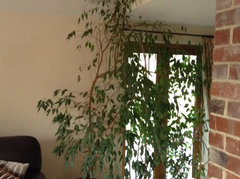Weeping Fig is losing its leaves worse than ever - root rot?
laazure
16 years ago
Featured Answer
Sort by:Oldest
Comments (24)
lucy
16 years agoRelated Professionals
Winder Landscape Architects & Landscape Designers · Stoughton Landscape Contractors · Alpharetta Landscape Contractors · Bedford Heights Landscape Contractors · Cornelius Landscape Contractors · Essex Landscape Contractors · Forest Hills Landscape Contractors · Galt Landscape Contractors · Morrisville Landscape Contractors · Natick Landscape Contractors · Old Saybrook Landscape Contractors · Plainview Landscape Contractors · Shoreview Landscape Contractors · Maplewood Landscape Contractors · Fountain Hills Interior Designers & Decoratorspepperomia
16 years agolaazure
16 years agomariateresa
16 years agobirdsnblooms
16 years agotapla (mid-Michigan, USDA z5b-6a)
16 years agobabs_bird
8 years agotapla (mid-Michigan, USDA z5b-6a)
8 years agolast modified: 8 years agoDave
8 years agobabs_bird
8 years agobabs_bird
8 years agoDave
8 years agolast modified: 8 years agotapla (mid-Michigan, USDA z5b-6a)
8 years agolast modified: 8 years agobabs_bird
8 years agotapla (mid-Michigan, USDA z5b-6a)
8 years agobabs_bird
8 years agobabs_bird
8 years agotapla (mid-Michigan, USDA z5b-6a)
8 years agoMentha (East TN, Zone 6B-7A)
8 years agobabs_bird
8 years agotapla (mid-Michigan, USDA z5b-6a)
8 years agobabs_bird
8 years agotapla (mid-Michigan, USDA z5b-6a)
8 years ago
Related Stories

HOUSEPLANTSPlay Up Some Fiddleleaf Figs for a Lively Indoor Tune
Strike a dramatic chord in a minimalist scene or a country note in a rustic setting — fiddleleaf fig plants harmonize with any style
Full Story
KITCHEN DESIGNHow to Lose Some of Your Upper Kitchen Cabinets
Lovely views, display-worthy objects and dramatic backsplashes are just some of the reasons to consider getting out the sledgehammer
Full Story
EARTH DAYThe Case for Losing the Traditional Lawn
Work less, help the environment and foster connections by just saying no to typical turf
Full Story
LANDSCAPE DESIGNIs It Time to Consider Fake Grass?
With more realistic-looking options than ever, synthetic turf can be a boon. Find the benefits and an installation how-to here
Full Story
TRADITIONAL ARCHITECTURERoots of Style: Pueblo Revival Architecture Welcomes Modern Life
Centuries-old details of adobe construction still appeal in the desert Southwest, adapted to today's tastes
Full Story
FALL GARDENING5 Ways to Put Fall Leaves to Work in Your Garden
Improve your soil and yard the organic way with a valuable garden booster that grows on trees
Full Story
DECORATING GUIDESThe Dumbest Decorating Decisions I’ve Ever Made
Caution: Do not try these at home
Full Story
MOST POPULARThe Most Incredible Kids' Tree House You'll Ever See?
Duck your head to enter this unforgettable Dallas wonderwork, lovingly crafted with imaginative delights
Full Story
HOUSEKEEPINGIt’s Time to Clean Your Gutters — Here’s How
Follow these steps to care for your gutters so they can continue to protect your house
Full Story
BASEMENTSDesign Workshop: Is It Time to Let Basements Become Extinct?
Costly and often unnecessary, basements may become obsolete — if they aren’t already. Here are responses to every reason to keep them around
Full Story











pageysgirl